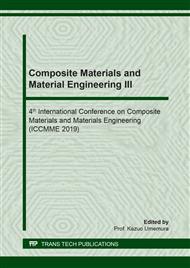p.39
p.47
p.53
p.59
p.65
p.71
p.77
p.83
p.89
Evaluation of 3D Embedded Element Technique in the Finite Element Analysis for the Composite
Abstract:
RVE combined with finite element analysis (FEA) is a very popular method to predict the mechanical property of the composite reinforced by short fibers. In the conventional method, generally the “tie” approach is used. By this method, the FE model with high fiber aspect ratio can not be achieved and the non-convergence of the numerical calculation may appear because of the complex mesh. The embedded element techinique is considered to be a replaceable method . Using this method, the mechanical behavior of composite with high fiber aspect ratio would be simulated. Therefore, in this study, the 3D solid element was employed for the FE model with multi cylinder particles. The comparisions of the Mise stress and the displacement between the embedded and conventional method indicate that compared with the stress transfer, the simulated result of composite stiffness is more accurate. In addition, the effects of model size, fiber orientated angle, fiber volume fraction and fiber aspect ratio were investigated. The numerical results were compared with the Mori-Tanaka model and the good agreements verify the applicability of the embedded element technique we studied in this paper.
Info:
Periodical:
Pages:
65-70
Citation:
Online since:
May 2019
Authors:
Keywords:
Price:
Сopyright:
© 2019 Trans Tech Publications Ltd. All Rights Reserved
Share:
Citation:


